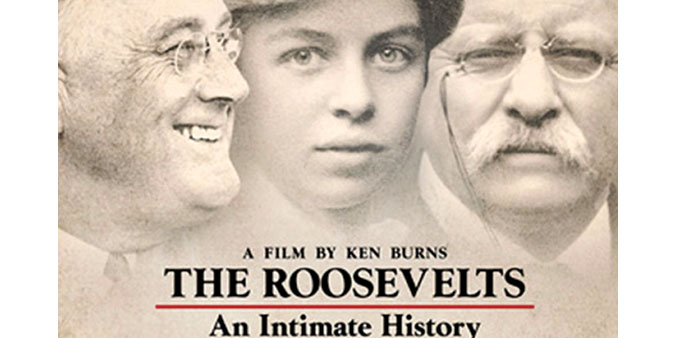Ken Burns not done yet as captivating documentary
maker on historical events. By Neal Justin
Anyone launching a course on US history could do a whole lot worse than revolving the curriculum around the films of Ken Burns. For example, The Civil War, the 1984 project that put Burns on the map, continues to be utilised in schools across the US.
“We’ve had letters from teachers as young as from the fourth grade saying, ‘We just showed the entire series, 15 minutes a day. It took us from November to February, but we did it,’?” said Burns, whose backlog of work also includes documentaries on baseball, the Brooklyn Bridge, Prohibition, the Dust Bowl and World War II. Burns’ tenure as the US’ most accessible, captivating professor is far from over. In fact, the filmmaker has a dizzying amount of projects in the pipeline, including The Roosevelts: An Intimate History, a 14-hour piece that runs seven straight nights on PBS. Among his upcoming offerings:
The Emperor of All Maladies, based on a book by oncologist Siddhartha Mukherjee that traces the history of cancer, is scheduled for next spring.
Jackie Robinson, a four-hour project planned for next autumn, tries to untangle the myth of the first black major leaguer, whom Burns first profiled in 1994’s Baseball.
Vietnam, which includes more than 300 interviews and includes unprecedented access to the Asian country’s archives, could stretch to 20 hours, according to Burns. It should premiere in 2016 or 2017.
Country Music, a 14-hour bookend to Jazz, is in the works, with luminaries like Rosanne Cash, Emmylou Harris and Vince Gill serving as advisers.
Ernest Hemingway is a biography of the great but complicated writer. The interviewing process started earlier this year, with a projected air date of 2019 or 2020.
Hemingway may still be a “gleam in our eye,” according to Burns, but he and his team have been working on the project for a decade. That’s not unusual. The Roosevelts was in development for 30 years.
Burns and his principal writer, Geoffrey Ward, knew that much has already been broadcast about America’s First Family, but taking on this story gave his team the chance to do what they do best: Show that history keeps repeating itself.
“It’s a family drama that brings in questions that are so contemporary,” Burns said. “What is the role of government? What is the nature of leadership? How do you interact as an important person, not only with your strengths, but your flaws? Heroism is not perfect, which is a lesson that goes back to the Greeks. It’s a lot like ‘Downton Abbey,’ but it has the added virtue of being both true and American.”
The Roosevelts saga utilises plenty of other Burns trademarks that have been spoofed by everything from The Simpsons to Drunk History. The sombre reading of letters by A-list actors. The endless reel of black-and-white photos. The sparse background music that sounds like it was recorded in a barnyard.
Most of all, there’s his tried-and-true approach to storytelling: 1) Tell ‘em what you’re going to tell ‘em; 2) Tell ‘em; 3) Tell ‘em what you told ‘em.
It may not be the flashiest style, but it’s held up nicely for more than 35 years.
What’s harder to wrap one’s head around is Burns’ thought process. In real life, he’s a natural raconteur who rarely works from a script, providing lengthy, impassioned answers to a myriad questions. Comment on the weather, and you’ll get a 10-minute monologue on the history of storm fronts. Juggling so many films at once seems to complement his intellectual strengths.
“All these projects feed each other,” he said. “I might wear a lot of hats as producer, director, executive producer, writer or whatever, but I’m able to see each film in the editing room each time in a new way, like the viewer would see it. Having so many things going on at once allows me to leave something and then come back and say, ‘OK, play me that first episode of Vietnam again and this time do it like that.’?”
Burns is already starting to consider ideas for the 2020s with his standard 10-year development plan in mind. But even though he looks like he just got out of graduate school, he’s now 60 years old. That’s partly why he’s working more with younger filmmakers including his daughter, Sarah Burns.
The two co-directed 2012’s The Central Park Five, which picked up a prestigious Peabody Award.
“If I were given a thousand years, I would not run out of topics in American history,” he said. “But I’m mindful of the fact that’s not going to happen to me.” — Star Tribune/MCT
John Travolta learns the art
of forging for new film
John Travolta, who was at the Toronto International Film Festival to attend the premiere of Philip Martin’s The Forger, has said he picked up some unusual skills while preparing for his role.
Travolta plays an expert art forger in the crime thriller who gets released from prison early so that he can spend time with his dying son, played by Tye Sheridan, a young American actor on the rise.
But Travolta is forced to pull off one major heist in return for the favour. Travolta said he was drawn to the story right off the bat, according to Xinhua. “This one beckoned me because I had never read anything quite like it. I loved the idea of playing an artist who was influenced by the wrong side of doing it,” he told reporters on the red carpet.
Travolta may have played many different roles throughout his career, but he did not take this one lightly. To prepare himself, Travolta said he learned the secrets of the trade by interviewing forgers and learning the craft. But he said it all came naturally to him.
“My grandfather was an artist and so was my father, and so it was in the family. I studied a little bit, I loved Edward Hopper. I did water colours, oil painting was newer to me, so studying with a man in Hong Kong helped me quite a bit. But the forgers also helped me understand the thinking behind authenticity and forgery,” he said.
Travolta shares the screen with Canadian acting legend Christopher Plummer, who plays his father. — IANS
Jennifer battles
construction company
Oscar-winning actress Jennifer Connelly has filed a lawsuit against a construction company for the shoddy roof work in her apartment. But the latter says Connelly is to blame. The 43-year-old owns a loft apartment and she hired the company to repair the roof of the building, a refurbished 1860s warehouse. According to the law suit, when a big storm hit in October 2010, poor quality work caused the loft to leak like a sieve, reports tmz.com. The construction company has sued Connelly. It says she let the roof fall into disrepair. The roofers say if a jury orders them to pay the insurance company, they want the judge to order Connelly to pay them back. — IANS



